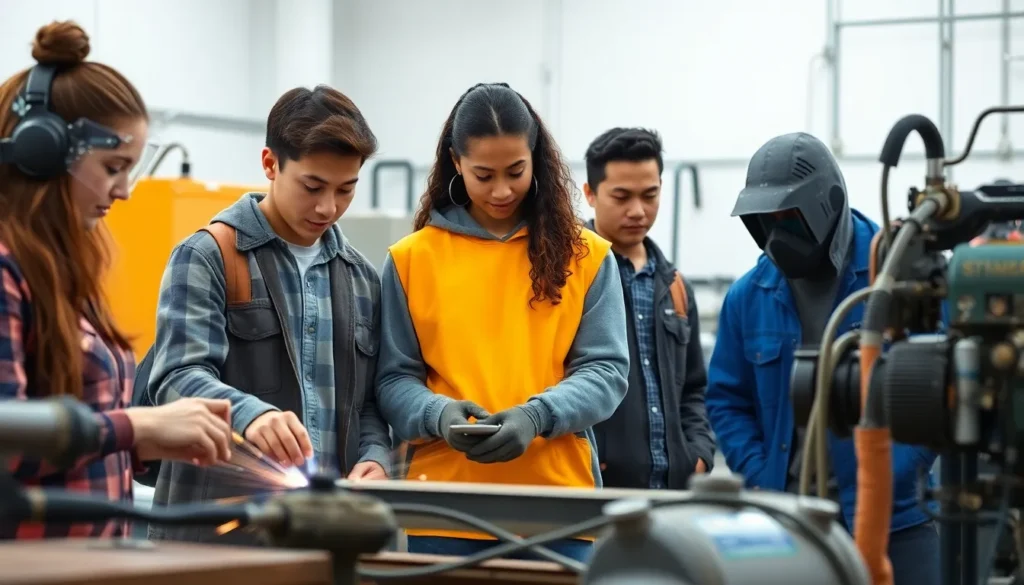In a world where the job market can feel like a game of musical chairs, vocational training emerges as the ultimate cheat code. Forget the endless lectures and mountains of textbooks—this hands-on approach gets individuals ready for the workforce faster than you can say “skills gap.” Whether it’s welding, coding, or culinary arts, vocational training offers a direct path to a fulfilling career without the hefty price tag of a four-year degree.
Imagine swapping those boring lectures for real-world experience. With vocational training, individuals dive right into the action, gaining practical skills that employers crave. It’s not just about learning; it’s about doing. So why not skip the fluff and get straight to the good stuff? Embracing vocational training could be the smartest decision one makes, turning passion into profession while keeping those student loans at bay.
Table of Contents
ToggleOverview Of Vocational Training
Vocational training provides practical education focused on specific careers. This form of training emphasizes hands-on skills, enabling individuals to learn efficiently. Numerous fields offer vocational programs, including welding, coding, and culinary arts.
Programs typically last from a few weeks to two years. Participants gain real-world experience, making them job-ready upon completion. In addition, these training opportunities help individuals avoid the debt associated with traditional college degrees.
Vocational training often occurs in community colleges, trade schools, or specialized institutes. These institutions provide tailored curriculum and expert instructors to guide students through their learning processes. Many programs include internships or apprenticeships, giving learners direct exposure to their chosen industries.
Employers often prefer candidates with vocational training due to their practical skillsets. Graduates demonstrate competence and readiness for immediate employment. Statistics show these graduates secure jobs faster than those with traditional degrees.
Vocational training appeals to a diverse range of individuals. Students seeking quick pathways to stable careers lean toward these programs. Adult learners aiming to switch career paths also find value in vocational education.
Overall, vocational training serves as a strategic approach to workforce entry. By focusing on essential skills and real-world applications, it equips individuals for success in various industries.
Importance Of Vocational Training

Vocational training plays a crucial role in shaping the modern workforce by providing essential skills and practical experience tailored to specific careers.
Skills Development
Participants in vocational training programs develop critical hands-on skills directly applicable in their chosen fields. Programs focus on subjects like welding, coding, and culinary arts, ensuring training aligns with industry demands. Individuals gain proficiency through practical exercises, which enhances their job readiness. Exposure to real-world scenarios prepares them for immediate employment opportunities. Moreover, workshops and simulations allow learners to practice and master techniques before entering the workforce. Trainees often engage in internships, which further solidify their skills while giving them a competitive edge in job markets.
Economic Impact
The economic influence of vocational training extends beyond individual participants. Job seekers with vocational training typically find employment more quickly compared to those with traditional degrees. Employers favor these candidates due to their focused skill sets, resulting in higher hiring rates. Studies show that over 70% of vocational graduates secure jobs within months of completing their programs. Additionally, vocational training reduces student debt burdens, allowing graduates to contribute positively to the economy sooner. Regions with robust vocational training programs often experience lower unemployment rates and increased job growth.
Types Of Vocational Training Programs
Vocational training encompasses various programs designed to equip individuals with practical skills tailored to specific careers. These programs cater to diverse learning preferences and career goals.
Traditional Apprenticeships
Traditional apprenticeships combine on-the-job training with classroom instruction. Participants work under the guidance of experienced professionals, gaining skills applicable to their chosen trades. Typically lasting from one to four years, these programs cover fields like plumbing, electrical work, and carpentry. Participants earn wages while learning, making the process financially sustainable. Employers value apprenticeship graduates for their hands-on experience and industry knowledge, often prioritizing their applications over those with less practical training.
Online Training Programs
Online training programs offer flexibility for individuals balancing other commitments. These courses cover a broad range of topics, including healthcare, information technology, and graphic design. Participants can complete coursework at their own pace, allowing them to fit learning into busy schedules. Many programs include interactive components, such as virtual simulations and discussions. Certificate completion often enhances employability, as employers recognize the credibility of online training programs from reputable institutions. The rise of remote learning options has made vocational training more accessible and appealing to a wider audience.
Challenges In Vocational Training
Vocational training faces several challenges that could impact its effectiveness and reach. Identifying these obstacles helps improve training programs and outcomes.
Funding And Accessibility
Funding remains a significant barrier for many aspiring vocational trainees. Government grants and financial aid options are often limited, making it difficult for individuals to enroll. High costs associated with materials and equipment can deter potential students from pursuing their desired careers. Many programs also struggle with accessibility in rural areas, where training centers are scarce. Ensuring adequate funding and expanding access to vocational programs can enhance opportunities for those interested in developing practical skills.
Perception And Awareness
Perception influences the popularity of vocational training among potential students. Many individuals view vocational paths as lesser options compared to traditional degrees. This misconception often leads to a lack of awareness regarding the benefits and viability of vocational careers. Advertising and outreach campaigns can help change perceptions and highlight success stories of vocational graduates. Building partnerships with local industries can also promote vocational training’s relevance, showcasing the demand for skilled workers in various fields.
Vocational training stands out as a vital pathway for individuals eager to enter the workforce with practical skills. By emphasizing hands-on experience and real-world applications, it prepares students for immediate employment in various fields. The benefits extend beyond personal achievement; they positively impact the economy by reducing unemployment rates and filling skill gaps in industries.
As society continues to evolve, the demand for skilled workers grows. Addressing the challenges related to funding and accessibility will further enhance the appeal of vocational training. By shifting perceptions and promoting its advantages, more individuals can discover fulfilling careers through this practical educational approach.





